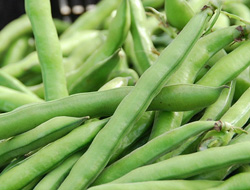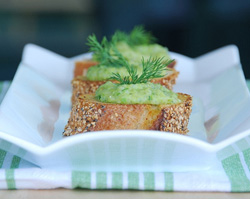 Finally, the wait is over! Fava beans are in season. They appeared for the first time last Sunday, and I couldn't be happier. I know how hard the wait has been on you too, but you can rest easy now. Well don't rest too easily. Fava beans have a depressingly short season--usually just 4-5 weeks in April-May.
Finally, the wait is over! Fava beans are in season. They appeared for the first time last Sunday, and I couldn't be happier. I know how hard the wait has been on you too, but you can rest easy now. Well don't rest too easily. Fava beans have a depressingly short season--usually just 4-5 weeks in April-May.
Fava (FAH vah) beans, like artichokes, asparagus, and English peas are a hallmark of spring time produce. These meaty, chewy legumes are exceptionally flavorful; they're similar in taste to edamame and have the firm texture of lima/butter beans. In general, the larger the pod, the better the bean. So when you see them, buy them, even if they're $3.00-4.00/pound. You won't be disappointed.
And don't worry about what to call them. According to Wiki and Cook's Thesaurus, you're correct if you say Vicia faba, broad bean, butter bean, faba bean, English bean, field bean, horse bean, tic bean, or Winsdor bean. I'm not making this up. I think someone actually wrote a dissertation entitled "The Many Appellations of the Bean, Fava."
So call 'em whatever you want, just don't miss them. And follow these instructions for shelling. They take a little effort because you have to shell them twice, but trust me, they're worth it.
— Snap the top off of the pod. Sometimes the pod will split easily down the seam, but sometimes you have to squeeze and twist the pod with your fingers till it pops and the beans are exposed.
— Remove the beans and discard the shells.
— Now you need to remove the waxy casing that encloses the fava bean. The easiest way is to boil the beans for 2 minutes, then drain them, and plunge in a bowl of ice water. Now for the fun part-- squeeze the casing gently between your thumb and forefinger and watch the fava bean pop out! Discard the waxy shell.
Now it's time to eat them, and you can eat a lot of them. A 1/2 cup of boiled fava beans is just over 90 calories and contains nearly 7 grams of protein and 5 grams of dietary fiber. They're high in calcium, iron, and folate. So enjoy them in salads, soups, pastas, and risottos. Or mash 'em up in spreads and dips.
 Fava Bean and Dill Crostini
Fava Bean and Dill Crostini
Yields 3/4-1 cup
3/4 cup shelled fava beans (about 1-1 1/4 pounds fresh fava beans in the shell)
1/2 cup red potato, diced
1 tablespoon plus 1 teaspoon Meyer lemon juice
1 tablespoon extra virgin olive oil
7-8 cranks black pepper
3 tablespoons fresh minced dill
2 tablespoons grated Reggiano-Parmigiano cheese
4 tablespoons water, or as needed
salt, to taste
1 baguette
Boil the fava beans in a small pot for 2-3 minutes; drain, and plunge into a bowl of ice water.
Meanwhile in a small pot, boil potatoes for 10 minutes, or until tender when pierced with a fork. Drain and let cool. Squeeze the casing gently between your thumb and forefinger and watch the fava bean pop out! Discard the waxy shells.
Place fava beans, potatoes, and remaining ingredients in a food processor and process until smooth. Use less water for a chunkier spread and more water for a smoother spread.
Toast bread slices. Spread bean mixture on toasts. Sprinkle with some sea salt, drizzle with some extra virgin oil oil, and top each with a sprig of fresh dill.
Note: If you can't find fava beans, then I suggest substituting lima/butter beans or edamame. I have also made this spread with fresh shelled English peas and fresh shelled sugar snap peas which are equally delicious.
- Originally published on Susan Russo's site FoodBlogga.

